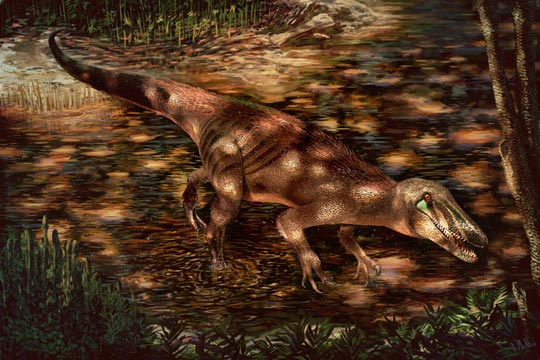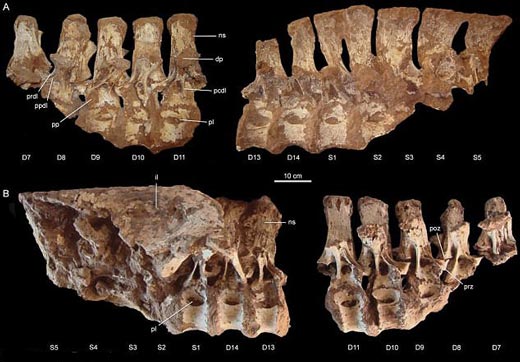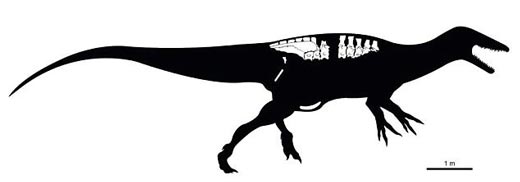A New Megaraptoran Theropod – Tratayenia rosalesi
After the Carcharodontosaurids Tratayenia rosalesi Ruled
Scientists have described a new type of megaraptoran theropod dinosaur from Upper Cretaceous strata in north-western Patagonia (Argentina). Although, less than five percent of the skeleton has been discovered, the fossil bones are similar to other megaraptorids such as Aerosteon (A. riocoloradense) and Megaraptor (M. namunhuaiquii). This has enabled the researchers, that include Juan Porfiri from the Museo de Ciencias Naturales (Buenos Aires), and Matthew Lamanna of the Carnegie Museum of Natural History (Pittsburgh), to confidently assign these fossils to the Megaraptora clade, the clade of “giant thieves”!
A Scientific Illustration of the New South American Megaraptoran T. rosalesi
Picture credit: Andrew McAfee (Carnegie Museum of Natural History)
Tratayenia rosalesi
Described from a series of articulated dorsal and sacral vertebrae, along with two ribs and elements of the hips, the dinosaur named Tratayenia rosalesi is estimated to have been around eight to nine metres in length, possibly even bigger. Tratayenia is the geologically youngest of the Megaraptora known to science and it is the first megaraptoran that preserves the complete sequence of sacral vertebrae (fused back bones located over the hips).
Its discovery has helped palaeontologists to learn more about the hips and pelvic region of these Late Cretaceous meat-eaters. The genus name is from Tratayén, the area in the eastern part of Neuquén Province from where the fossils come from. The trivial name honours Diego Rosales who made the initial fossil discovery. Tratayenia rosalesi is pronounced tra-ta-yen-nee-ah rose-ah-less-eye.
View of the Articulated Dorsal and Sacral Vertebrae (Tratayenia rosalesi)
Picture credit: Cretaceous Research
Santonian Faunal Stage
The fossil material comes from a horizon of Upper Cretaceous-aged deposits (Santonian faunal stage), in the Bajo de la Carpa Formation of the Neuquén Group (Neuquén Basin), exposed close to the small town of Añelo. Notwithstanding the fact that the age of the fossil material representing the megaraptorids Aerosteon and Orkoraptor (O. burkei) remains uncertain, these fossils could describe the geologically youngest megaraptoran to date, thus extending their temporal range. In addition, it is the largest carnivorous vertebrate to have been found in the Bajo de la Carpa Formation, as such, the researchers speculate that this fearsome, long-jawed, long-clawed dinosaur was an apex predator.
Based on comparisons with close relatives like Megaraptor, palaeontologists estimate that this carnivorous dinosaur sported two, forty-centimetre-long talons on the innermost fingers of each hand. The discovery of Tratayenia adds weight to the hypothesis that the megaraptorids became the top predators in the southern parts of Gondwana following the extinction of the carcharodontosaurids.
An Illustration of Tratayenia rosalesi Showing Known Fossil Material
Picture credit: Cretaceous Research
Megaraptoran Dinosaurs
An article that explains more about the megaraptoran dinosaurs including Murusraptor: Getting Our Claws into the Megaraptora.
For an article that outlines the potential origins of the Megaraptora: “Lightning Claw” – A Deadly Predator.
The scientific paper: “A New Megaraptoran Theropod Dinosaur from the Upper Cretaceous Bajo de la Carpa Formation of North-western Patagonia” by Juan D. Porfiri, Rubén D.Juárez Valieri, Domenica D.D.Santos and Matthew C. Lamanna published in the journal “Cretaceous Research”.
Visit the award-winning Everything Dinosaur website: Everything Dinosaur.




